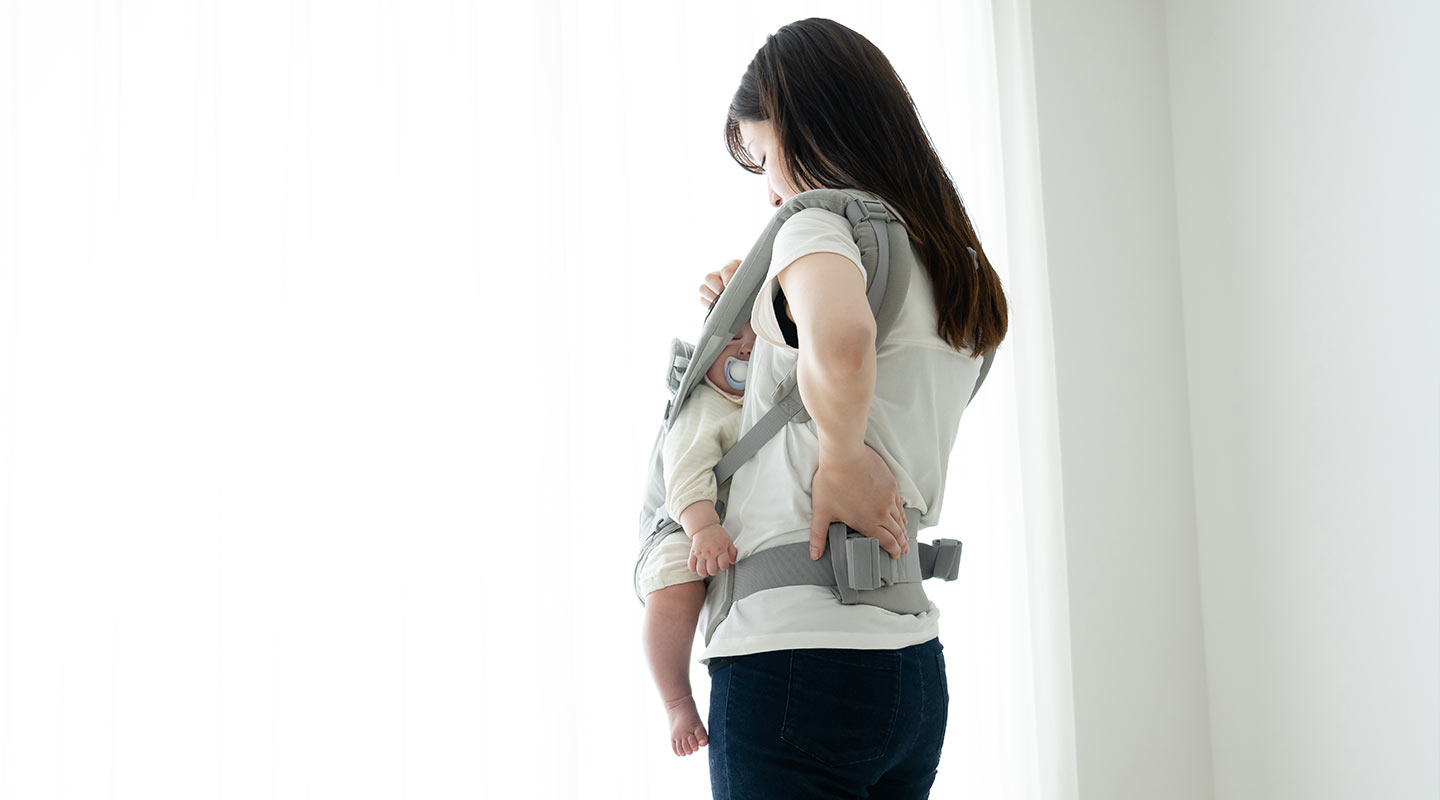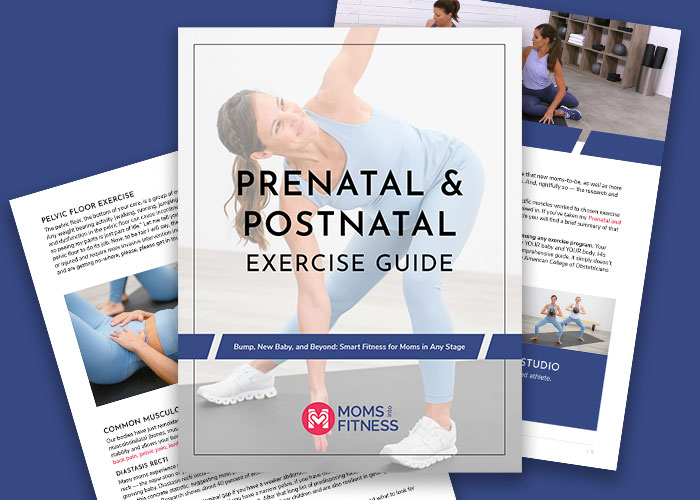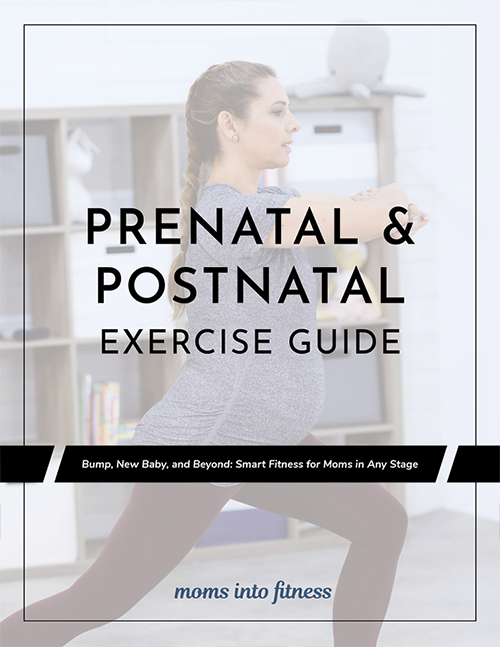
by Megan Hoover, DPT, contributor to Prenatal & Postnatal Fitness Specialist Course
Immediately after delivery, the uterus contracts as it begins to return to its pre-pregnancy size. The body, again in an amazing feat, does all of this as soon as the placenta is delivered. Within the first two weeks, the bump caused by the expanded uterus is less noticeable. By six to eight weeks postpartum, the uterus attains its normal non-pregnant size. But your body will hold extra weight and experience musculoskeletal issues for several months — after all, it just housed a tiny human!
For a comprehensive guide on how to approach postpartum fitness safely and effectively, download our Prenatal and Postnatal Exercise Guide.
Smart fitness for moms in any stage: bump, new baby, and beyond.


Back pain is one of the most common musculoskeletal complaints. Our bodies have just remodeled their structure to support these incredible little miracles, then they are here, and your body has to hold up to the demands of caring for these sweet lil’ babies. Not only do our biomechanics change (pelvic widening, increased swayback, external rotation of hips due to tight rotators), our bodies are still producing relaxin, a hormone released during pregnancy to relax all our tendons and ligaments to prepare for delivery. We continue to produce relaxin up to six months after discontinuing breastfeeding. So … now we are dealing with changed mechanics, laxity in ligaments, and the new positions we find ourselves in when caring for our kiddos. It’s important that we learn the correct ways to hold, carry, and lift so we don’t injure ourselves.
Our bodies are truly amazing, but we can reach mechanical failure, which can cause back pain. Back pain has many drivers/causes, but especially after pregnancy, our muscles need to be retaught to fire correctly, our mechanics need to be addressed, and core stability and muscle flexibility all need to be taken into consideration. Just a few drivers of back pain include: altered pelvic mechanics, laxity and weakness in the pelvic floor, inhibition of deep hip rotators and transverse abdominis, excessive lordosis/swayback, tight hip flexors … and the list goes on.
If you find that you are having back pain post pregnancy and have tried to address it through our Postnatal Program without significant improvement, you would benefit from following up with a physical or physiotherapist to help you address your pain and get back to the things you love! You are worth it, mama!
Musculoskeletal issues can stick around for years after having a baby. If you need a great program to address any core issues, try Core Restore.
Sciatic pain, which is described as pain that radiates down your buttock and sometimes into your leg, is also a common musculoskeletal issue both during pregnancy and postpartum. Unfortunately, this one can be tricky as well. There can be many sources that cause this common pain. It can be dysfunction in the low back irritating a nerve within the back. It can be a tight piriformis putting pressure on the sciatic nerve. It can be an issue at the pelvis causing altered leg length and overload of our muscle system, which aggravate the surrounding nerves. Boy, we are complicated, amazing creatures! A physical therapist can help you assess your cause and give you exercises or stretches.
Yes … your grandmother was correct … posture matters! It’s not just the 30 minutes of exercise, but the other 800 minutes of the day that matter just as much! Our muscles, joints, nerves, bones, and connective tissues all have to work together to get us through our day. The position we hold our bodies in matters. Poor prolonged posturing can drive excessive lordosis (swayback) and kyphosis (hunchback).
Pregnancy changes our entire structure and causes increased lordosis due to weight of baby in front. This can get better after delivery but think about how you hold your baby. Most of us (myself included) have locked out our knees when we are rocking our sweet bundle to sleep or when trying to wrangle them with one hand on your hip while also trying to cook dinner. We lock out our knees, which drives our behinds further behind us creating that excessive lumbar lordosis or swayback. Nursing and wrangling kiddos can aggravate and drive thoracic (upper back) kyphosis because we are in a forward position for long periods of time. Kyphosis is a posture that all of us must work on because life happens in front of us.
Do not beat yourself up about your posture! The important thing is to know how to correct it through body mechanics, core and postural stability, and muscle flexibility. Moms Into Fitness Studio has excellent resources on stretching, core stability, and functional movement.
Many moms experience postpartum body changes. One of these is an incredibly common condition called diastasis recti, which affects up to 45 percent of women six months postpartum.
Diastasis is the term for the separation of parts of your body that are normally not separated. One of the most common types of diastasis in the human body is diastasis recti, which is the separation of the rectus abdominis muscle.
Your rectus abdominal muscles, which hold in your internal organs, run along your abdomen from your sternum to your pubic bone in two parallel bands. These muscle bands are connected by a bit of connective tissue in the middle called the linea alba. This connective tissue is where the separation occurs. All bodies have some separation due to the fact that the recti bellies are connected with this connective tissue. How wide this diastasis (or separation) is determines if you need to modify your exercise routine.
Diastasis recti can happen to anyone, including men, babies, and children. However, most cases occur in women due to pregnancy.
Learn more about diastasis recti, including how to test yourself, in our Core Restore program.
Pelvic pain is very common during pregnancy and following delivery. Your pelvic floor just carried all the weight of that baby for 10 months, and then you went through delivery. Vaginal deliveries involve the trauma of making room for the baby to come through, and cesarean deliveries involve disruption of the tissues in the front of your abdomen. Both have a significant impact on our pelvic mechanics and ability to perform all our normal activities and jobs in a pain free manner. As mentioned above, relaxin causes laxity in our ligaments. Our pelvis is made up of bones that are tethered together by the ligaments and muscle tendons surrounding the pelvis and sacrum. And there are a bunch them!
It is important to keep working the core with the pelvic tilts, kegels, and foundation moves. Download our Prenatal and Postnatal Exercise Guide for more info! Additionally, some women find it feels better to have compression through the pelvis and use a support belt.
It is best to avoid certain moves and exercises. You should avoid the following:
Pelvic pain can be tricky to address on your own as there are so many things that impact pelvic mechanics, pelvic floor health, and trauma that can occur during delivery. If you are having pelvic pain that is not going away with gentle exercise, stretching, or a postnatal exercise program, please follow up with a women’s health physical or physiotherapist. Their job is to assess the cause of your pain, help you get back to life faster, and teach you how to take care yourself. Do not put up with pelvic pain, ladies! It can be so debilitating.
Seek a referral to a women’s health / pelvic health PT if you:
Below we explain in more detail some of the conditions they can help with.
Both vaginal and cesarean deliveries can cause incontinence postpartum. Mommas who have had vaginal deliveries tend to have more difficulty with incontinence, but not always. From overloading of our pelvic floor during pregnancy to the trauma of delivery, our plumbing takes a hit. But there is hope! We need to train those pelvic floor muscles that hold up our bladder and give the bottom of our abdominal canister some integrity.
Our transverse abdominis and pelvic floor muscles have fascial ties (part of our connective tissue) that help them work together. So, when you work your TA, you are also getting those pelvic floor muscles to fire. However, we also need to intentionally activate those muscles as well to get them stronger and have better endurance. We can selectively train our pelvic floor muscles! Kegels are a great place to start. If you are a runner, be sure to check out Running and the Pelvic Floor.
Incontinence can be hugely improved if not be eliminated with the help of a women’s health physical or physiotherapist. They have specialty training to help activate those muscles and retrain them how to fire. Please do not put up with incontinence just because someone says it’s “normal” after having kids. It may be common, but it is NOT NORMAL!
If you had any degree of tearing during your vaginal delivery, you are at risk for experiencing pelvic and vaginal pain, common with exercise, normal movement, and sexual intercourse. This could go on for years if left untreated.
Tearing during delivery causes major scarring and needs to be addressed, just like a C-section scar. Yikes! I know this can sound overwhelming, uncomfortable, and weird, but those tissues down there need to be helped so they can function how they are intended to. Women’s health physical therapists or physiotherapists leverage external and internal treatments that can help you get back to pain-free movement and activity. Now, there are definitely times when more intervention is required (e.g., extensive tearing leading to prolapse), and a PT will be able to get you set up with the appropriate MD to address these issues as well. Our muscles in our pelvic floor are essential to keeping our bodies healthy not only when it comes to our musculoskeletal system, but also our urinary system and digestive systems as well!
This condition can be almost debilitating to a pregnant woman and can produce symptoms months after delivery. To ease the symptoms, you should work the pelvic floor muscles. It is best that you work one-on-one with a physical therapist.
In the most serious cases of disruption of or damage to the muscles of the pelvic floor, your muscles could prolapse. Pelvic organ prolapse occurs when the pelvic floor muscles become weak or damaged and can no longer support the pelvic organs. The uterus is the only organ that actually falls into the vagina. When the bladder and bowel slip out of place, they push into the walls of the vagina. While prolapse is not considered a life-threatening condition, it may cause a great deal of discomfort and distress. You will want to see your doctor if you suspect you have a prolapse. Pelvic floor physical therapy can be helpful.
Many women dread having a C-section because of the trauma to their abdomen and resulting scarring. Our doctors have come a long way from our mothers’ and grandmothers’ days of abdominal zippers, where you are scarred from sternum to pelvis. The incisions now are so much smaller, and our bodies are amazing at recovering from this procedure. While they do not cut into the abdominal muscles, the tissues are stretched, pulled, and manipulated to get that baby out! This is hard on those tissues, and they need some tender loving to get them back to functioning the way they were designed.
Following a C-section, your body needs time to heal. After it is fully healed, it is very important to work the scar itself. View these scar mobilization tips to help you regain core strength, function, and reduce look of your C-section scar “pooch” or shelf (for lack of a better term).
Postpartum is such a delicate time physically and emotionally. Please be gentle with yourself, momma, as you recovery and start to work on your fitness again (or maybe for the first time). Moms Into Fitness was created to support moms in all stages of life and all levels of fitness. Check out our Postpartum Program, which will ease you back in with gentle functional movements that are safe for your body.
Whatever your approach, remember the importance of BALANCE! And I’m not just talking about being able to stand on one foot. I’m talking about moving your body intentionally, balancing strength exercises with flexibility, and working on posture, alignment, and stability. All of these are key to proper recovery and injury prevention, and are constantly weaved throughout our Moms Into Fitness programs.
Our bodies were made for movement. They were designed to withstand all different postures, positions, movements, and forces. However, we need to take the appropriate steps to keep our bodies healthy so we can successfully manage normal tasks.
Many people think of stretching and postural activities as “exercise.” While they are “exercises,” they are essential for everyday movement. If you do not have adequate hip-flexor mobility, you are going to be more prone to low-back issues and excessive lumbar lordosis. Tight calf muscles can prevent efficient walking and cause excessive load at the ankle and foot causing plantar fasciitis. Poor rotation at the hips due to a tight piriformis, can drive issues at the sacrum and pelvis, making it painful/hard to do a variety of normal activities.
By doing stretching/postural “exercises,” you can improve and prevent aches and pains that can limit the activities you love, or ability to perform the tasks required of you.
Okay, so here is where I get on my soap box for just a second. Flexibility is very important for normal movement and mechanics. However, without the stability and control to efficiently perform a movement, our bodies will fail.
Many people will be diligently stretching all their tight muscles for weeks and still feel tight. If you have weakness in a muscle or area of your body, the surrounding muscles will get tight to help control a movement. If you do not work to get that muscle or group of muscles stronger, stretching alone can make it worse. Now, there are people who are just tight/restricted by nature, and yes, if you are one of these individuals, stretching is going to need to be one of your daily routines … forever. However, many of us are very good at working flexibility, but we overlook strength and stability.
Stability is the body’s ability to control a joint through motion or activity with appropriate speed and quality of movement. Your pelvis/hip must stabilize the leg you are standing on to bring the other leg through to walk. If your glutes are weak, you cannot control this motion, and will use your joints to stabilize. Over time, you will reach mechanical failure. This may show up in the form of low back pain, pelvic pain, knee pain, or plantar fasciitis, just to name a few. We must be able to control the motions we put our bodies through whether it is just daily activities or recreational sports and exercise.
Strength training is also very important to increase the tolerance for load on our joints and structure. Depending on what your day and life looks like, you will need to train your body to be able to hold up to what you love to do. Whether it is chasing your kiddos around the yard, running a marathon, or taking up power lifting (gulp), your body has to be able to effectively manage and control your movement and positions. You will need to specifically strengthen your body/muscle groups to be able to withstand the physical demands you are going to put your body through. For example, a marathon runner needs to run to build endurance, but if she does not appropriately strengthen the muscles that control side-to-side and rotatory motions (e.g., glutes, adductors, core), she will eventually end up with a repetitive injury.
Now, there are those who want to just work strength and stability … you ladies need flexibility as well. I am guilty of this, so I am preaching to myself as well. We cannot just beat up on our muscles day-in and day-out and expect them just to take it. “We need to lengthen, after we strengthen,” as I say. The health of our muscles and joints is dependent on the health of our tissues. Flexibility, strengthening, stabilization exercises, postural alignment, and hydration are all components of keeping our bodies healthy so we can do what we love!